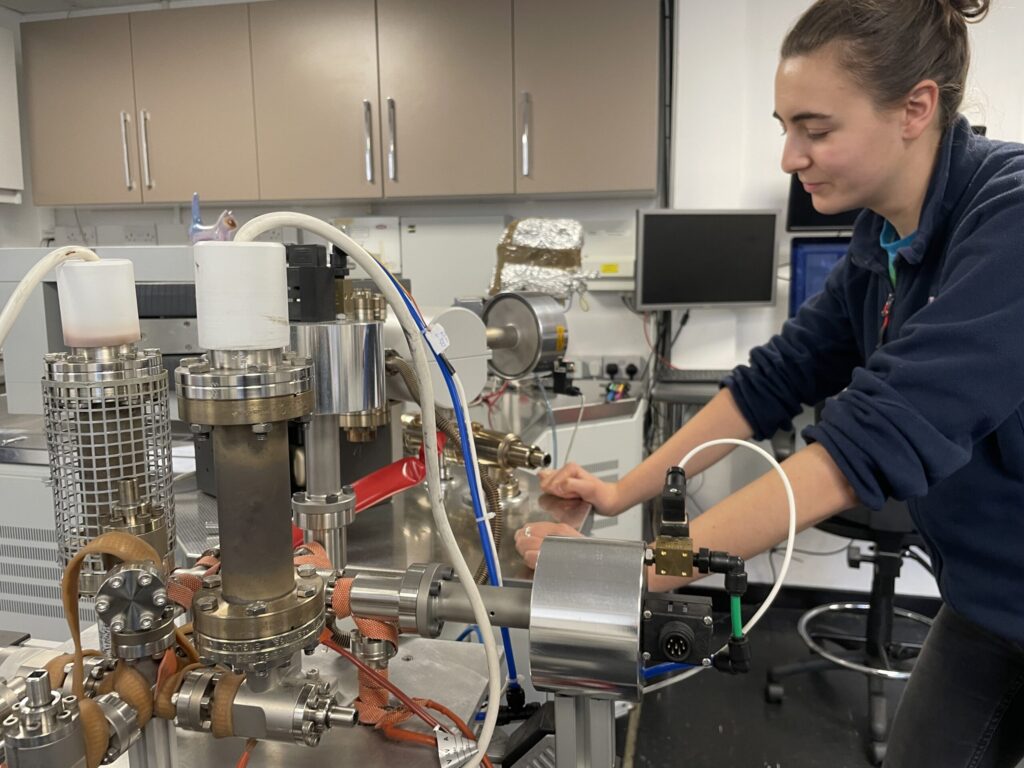Post contributed by Rhiannon Rees – final year PhD student at the University of Southampton
I am a final year geology PhD student at the University of Southampton studying rift volcanism in East Africa, and I recently undertook a supported three-month placement with the National Environmental Isotope Facility (NEIF) Argon Isotopes research lab at SUERC. In this blog post I’ll share my experience of doing a placement at SUERC.
How and why did I apply for a placement?
In May 2022 I attended a week-long course on geochronology, delivered by NEIF at SUERC. I didn’t know much about geochronology at all before attending the course, but I wanted to learn more about the theories and methods used in geochronology, I was also keen to get some more lab and field experience. I had started my PhD just 6 months before the first national lockdown in 2020 and had spent much of the first 2 years of my PhD working from my bedroom at home.
At the end of the course I asked Darren Mark if SUERC would be open to hosting me as a placement student. My doctoral training partnership (NERC INSPIRE DTP) in Southampton offers the opportunity to apply for funding to complete a placement at another institution, so after approval from SUERC, I put together an application. I was successful in securing the funding, so I packed my bags for three months in sunny Glasgow!
What does a typical day on placement involve?
My placement was very practical, and broadly involved learning the ‘rock to age’ process for preparation of rock samples for 40Ar/39Ar dating. As a result, each day was slightly different. I learned the techniques involved in each step of sample processing, starting from whole rock samples and ending with how the data is processed. I also joined local field trips, collecting rock samples for other PhD students, and developing my insight into the application of the method.
I prepared two types of samples – two lavas for dating using the 40Ar/39Ar technique, and a sample of the Fish Canyon Tuff, which is a rock used as an age standard for argon dating in many labs.

What new technical skills did I learn?
I learned a range of new lab techniques whilst doing sample preparation, including using SUERC’s new SELFRAG machine. The SELFRAG breaks apart crystalline rocks along their grain boundaries using high voltage pulsed electric power (as opposed to traditional physical crushing methods, which can damage individual crystals and make them harder to analyse). Following crushing, I separated and sorted the crushed material by size (using wet and dry sieving), by magnetic susceptibility (using a Frantz magnetic separator), and by density (using heavy liquid separation).
These processes make it possible to isolate certain types of crystals and grains from the crushed material. I then spent time hand-selecting tiny individual sanidine phenocrysts and groundmass grains using a microscope and fine tweezers. These carefully picked grains will be sent off for irradiation in the Oregon State University reactor in the USA, after which they are posted back to East Kilbride for analysis.

As well as preparing samples from whole rock, I learned about the setup, calibration and sample run procedure of 40Ar/39Ar samples on the custom Helix Split Flight Tube Mass Spectrometer (Helix-SFT) at SUERC. The Helix SFT allows for the simultaneous analysis of argon isotopes, from which the age of the sample is calculated using an age equation.

What experiences will I take back with me?
Overall, my placement at SUERC was a fantastic experience. Many of the facilities at SUERC are not found at other research institutions in the UK, so my placement gave me the opportunity to learn many new laboratory and analytical techniques which I would not have otherwise had the chance to. Although the topic of my PhD is quite different to what I did for my placement, I will take back and be able to apply many of the skills and principles I learnt to my future work – for example, developing optimised workflows in the lab when working on samples that require multiple steps during processing.
What advice would I have for PhD students considering a placement?
Although it may seem daunting to reach out to potential placement partners and ask if you can complete a placement with them, I would encourage any PhD student to undertake a placement at a different institution if they get the chance. Working on another project in a different organisation – whether it be an academic placement with another university, or an industry or policy placement with a private or government body – gives you not only a chance to broaden your skills and meet new people, but it is also beneficial in giving a new perspective on your own PhD research.
Rhiannon Rees – final year PhD student at the University of Southampton – r.rees@soton.ac.uk
This placement was supported by the Natural Environmental Research Council [grant number NE/S007210/1]. I’m incredibly grateful to everyone at SUERC who took the time to help, supervise and teach me during my placement.
